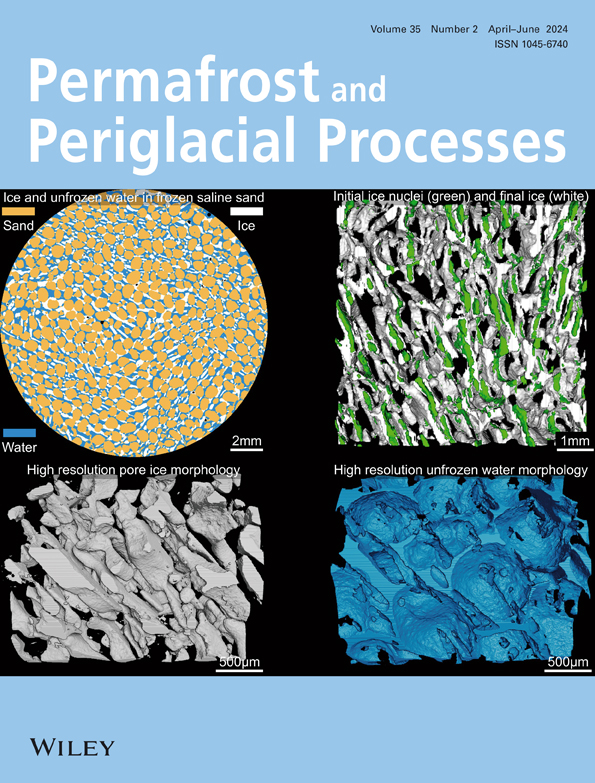利用TTOP绘制蒙古多年冻土空间分布图
IF 3.3
3区 地球科学
Q2 GEOGRAPHY, PHYSICAL
引用次数: 2
摘要
本研究介绍了基于TTOP(永久冻土顶部温度)方法的蒙古永久冻土制图结果,该方法在不同地点的现场测量中得到了验证。实测表明,年平均地温(MAGT)年际变化在0.6 ~ 2.2°C之间,在远离0°C时变化最大。在冻土处于非平衡状态并主要受局部因素控制的地区,模拟和实测的MAGTs之间的差异超过±1°C。据估计,永久冻土层占蒙古国土面积的三分之一。我们将永久冻土的范围划分为五个区域:连续、不连续、零星、孤立和季节性冻土。多年冻土带面积约462.8 × 103 km2,占蒙古国土面积的29.3%。其中,连续多年冻土118.3 × 103 km2(7.5%),不连续多年冻土127.7 × 103 km2(8.1%),零星多年冻土112.4 × 103 km2(7.1%),孤立多年冻土104.4 × 103 km2(6.6%)。本文章由计算机程序翻译,如有差异,请以英文原文为准。
Spatial distribution mapping of permafrost in Mongolia using TTOP
This study presents the results of permafrost mapping in Mongolia based on the TTOP (temperature‐on‐top‐of‐permafrost) approach, which were validated against in situ measurements at various locations. In situ measurements indicated that the mean annual ground temperature (MAGT) ranged from 0.6 to 2.2°C interannually, showing the greatest variability when furthest from 0°C. The differences between the modeled and measured MAGTs exceeded ±1°C in locations where permafrost was in a nonequilibrium state and was controlled predominantly by local factors. It was estimated that permafrost occupies one‐third of Mongolia. We divided the extent of the permafrost into five zones: continuous, discontinuous, sporadic, isolated, and seasonally frozen ground. In total, the permafrost zones cover ~462.8 × 103 km2, accounting for 29.3% of Mongolia. Of this total area, continuous permafrost accounted for 118.3 × 103 km2 (7.5%), discontinuous permafrost 127.7 × 103 km2 (8.1%), sporadic permafrost 112.4 × 103 km2 (7.1%), and isolated permafrost 104.4 × 103 km2 (6.6%).
求助全文
通过发布文献求助,成功后即可免费获取论文全文。
去求助
来源期刊
CiteScore
9.70
自引率
8.00%
发文量
43
审稿时长
>12 weeks
期刊介绍:
Permafrost and Periglacial Processes is an international journal dedicated to the rapid publication of scientific and technical papers concerned with earth surface cryogenic processes, landforms and sediments present in a variety of (Sub) Arctic, Antarctic and High Mountain environments. It provides an efficient vehicle of communication amongst those with an interest in the cold, non-glacial geosciences. The focus is on (1) original research based on geomorphological, hydrological, sedimentological, geotechnical and engineering aspects of these areas and (2) original research carried out upon relict features where the objective has been to reconstruct the nature of the processes and/or palaeoenvironments which gave rise to these features, as opposed to purely stratigraphical considerations. The journal also publishes short communications, reviews, discussions and book reviews. The high scientific standard, interdisciplinary character and worldwide representation of PPP are maintained by regional editorial support and a rigorous refereeing system.

 求助内容:
求助内容: 应助结果提醒方式:
应助结果提醒方式:


